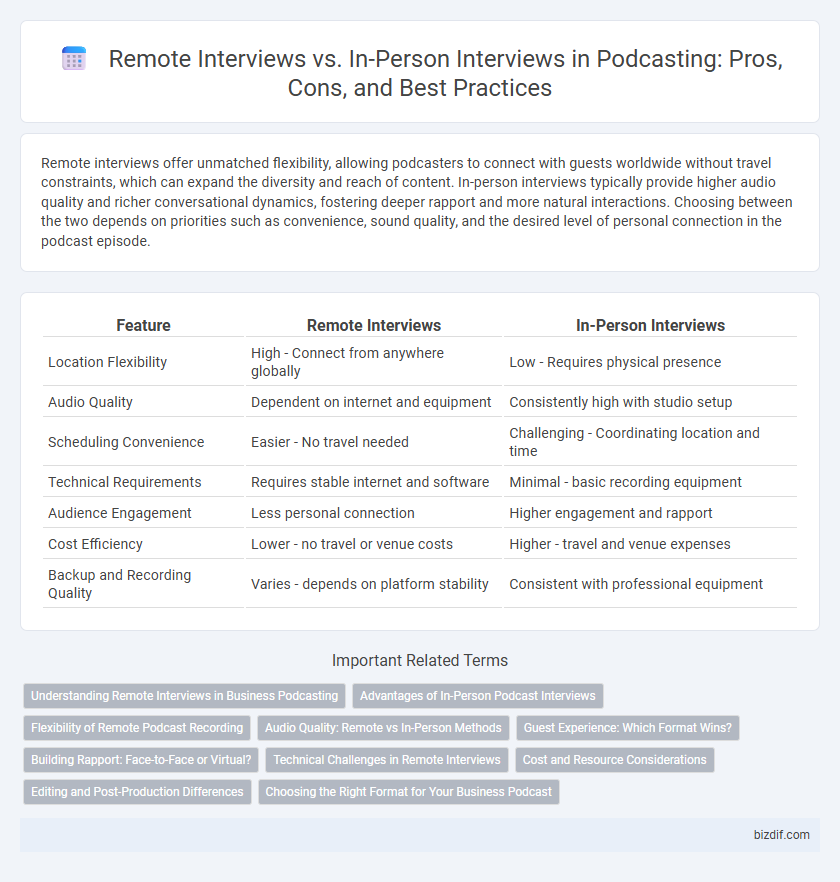Remote interviews offer unmatched flexibility, allowing podcasters to connect with guests worldwide without travel constraints, which can expand the diversity and reach of content. In-person interviews typically provide higher audio quality and richer conversational dynamics, fostering deeper rapport and more natural interactions. Choosing between the two depends on priorities such as convenience, sound quality, and the desired level of personal connection in the podcast episode.
Table of Comparison
| Feature | Remote Interviews | In-Person Interviews |
|---|---|---|
| Location Flexibility | High - Connect from anywhere globally | Low - Requires physical presence |
| Audio Quality | Dependent on internet and equipment | Consistently high with studio setup |
| Scheduling Convenience | Easier - No travel needed | Challenging - Coordinating location and time |
| Technical Requirements | Requires stable internet and software | Minimal - basic recording equipment |
| Audience Engagement | Less personal connection | Higher engagement and rapport |
| Cost Efficiency | Lower - no travel or venue costs | Higher - travel and venue expenses |
| Backup and Recording Quality | Varies - depends on platform stability | Consistent with professional equipment |
Understanding Remote Interviews in Business Podcasting
Remote interviews in business podcasting leverage digital platforms like Zoom or Skype to connect hosts and guests across different locations, enabling flexible and cost-effective content creation. High-quality audio equipment and stable internet connections are essential to maintain sound clarity and professionalism. Understanding the nuances of remote interviews helps podcasters optimize engagement and deliver insightful conversations without geographical constraints.
Advantages of In-Person Podcast Interviews
In-person podcast interviews offer superior sound quality through controlled environments and professional recording equipment, enhancing listener experience. They establish stronger rapport and non-verbal communication cues between host and guest, leading to more engaging and authentic conversations. Networking opportunities increase as in-person settings facilitate spontaneous interactions and collaborations beyond the recorded session.
Flexibility of Remote Podcast Recording
Remote podcast recording offers unparalleled flexibility by enabling hosts and guests to connect from any location worldwide without the constraints of travel or scheduling conflicts. This method supports asynchronous workflows, allowing participants to record at their convenience while maintaining audio quality through advanced software. Consequently, remote interviews expand access to diverse voices and streamline production timelines, enhancing overall podcasting efficiency.
Audio Quality: Remote vs In-Person Methods
Remote interviews often face challenges like internet lag and background noise, which can degrade audio quality and require advanced noise reduction tools. In-person interviews typically provide clearer, richer sound due to controlled environments and professional audio equipment proximity. High-quality microphones, acoustic treatment, and minimal interference in physical settings enhance listener experience compared to remote setups.
Guest Experience: Which Format Wins?
Remote interviews provide unparalleled convenience and comfort for podcast guests, eliminating travel time and allowing participation from familiar environments. In-person interviews offer richer interpersonal connection and nuanced body language cues that enhance guest engagement and authenticity. Ultimately, guest preference often hinges on balancing ease of access with the desire for deeper, face-to-face interaction during podcast recordings.
Building Rapport: Face-to-Face or Virtual?
Building rapport in podcast interviews hinges on communication nuances; in-person interviews offer richer non-verbal cues and immediate feedback that enhance emotional connection. Remote interviews depend heavily on vocal tone and active listening to create intimacy despite physical distance, requiring advanced technical setup to minimize distractions. Both formats benefit from intentional preparation and empathy, yet face-to-face settings naturally foster stronger interpersonal bonds crucial for engaging podcast storytelling.
Technical Challenges in Remote Interviews
Remote podcast interviews often face technical challenges such as unstable internet connections, audio latency, and synchronization issues between participants. These problems can degrade sound quality, causing interruptions, dropped calls, or misaligned audio tracks that complicate post-production editing. Ensuring high-quality remote interviews requires reliable hardware, software optimized for low-latency communication, and pre-interview technical checks to minimize disruptions.
Cost and Resource Considerations
Remote interviews significantly reduce costs by eliminating travel expenses, venue rentals, and on-site equipment setup, making them ideal for budget-conscious podcasters. They also save time and resources by allowing flexible scheduling and leveraging readily available digital tools for recording and editing. In contrast, in-person interviews may require higher investment in logistics and technical support but can offer enhanced audio quality and more engaging, dynamic interactions.
Editing and Post-Production Differences
Remote interviews often require advanced audio editing to address variable sound quality, background noise, and latency issues, making post-production more time-intensive compared to in-person interviews. In-person interviews typically provide cleaner audio tracks with consistent acoustics, simplifying editing and reducing the need for extensive noise reduction. The ability to capture multiple audio sources directly during in-person sessions streamlines synchronization and mixing, enhancing overall production efficiency.
Choosing the Right Format for Your Business Podcast
Remote interviews offer flexibility and access to a wider range of guests without geographical constraints, making them ideal for businesses seeking diverse expert opinions. In-person interviews provide higher audio quality and foster deeper personal connections, enhancing listener engagement through authentic interactions. Evaluate your podcast's goals, technical resources, and audience preferences to determine the best format that aligns with your brand and content strategy.
Remote Interviews vs In-Person Interviews Infographic

 bizdif.com
bizdif.com